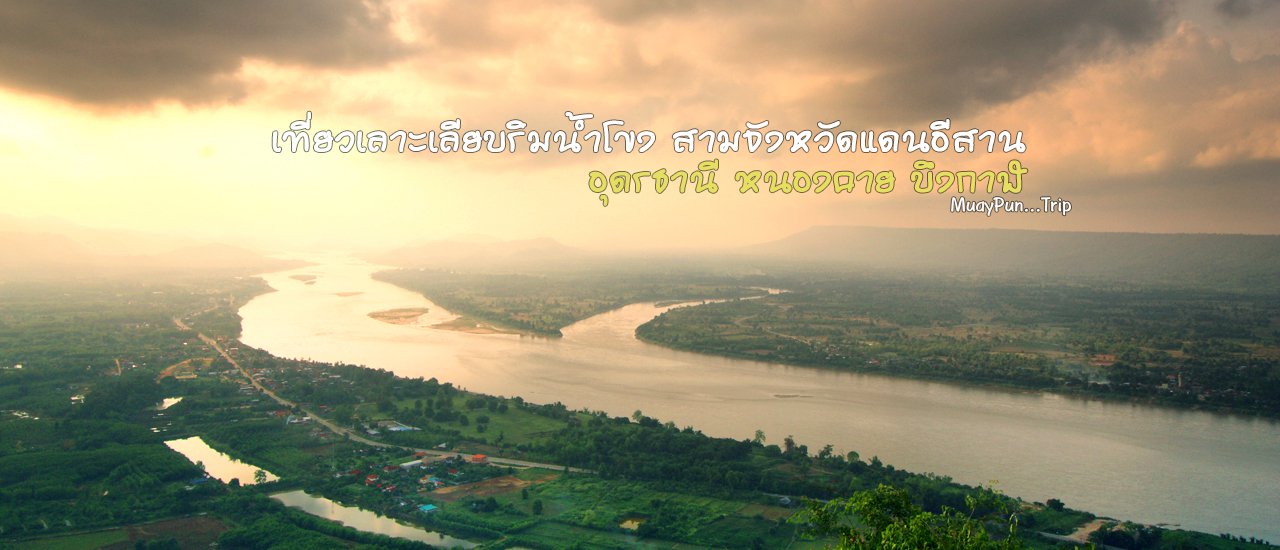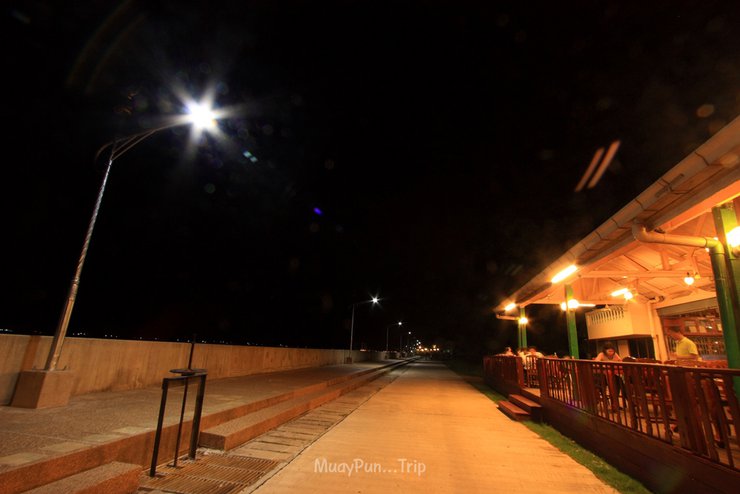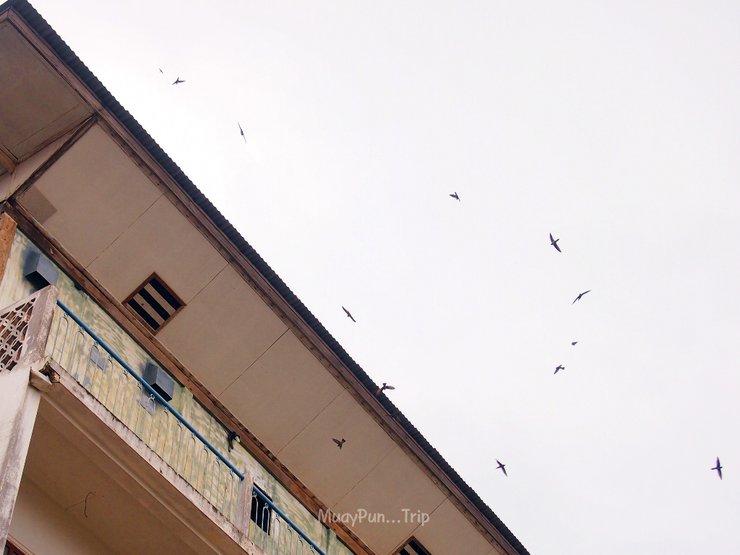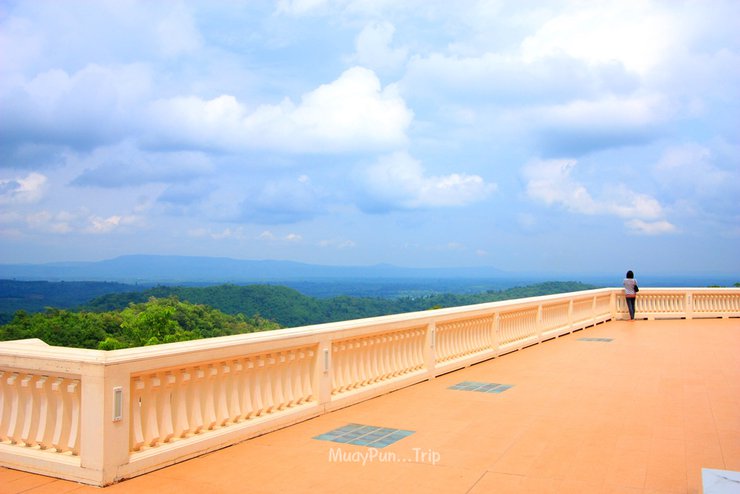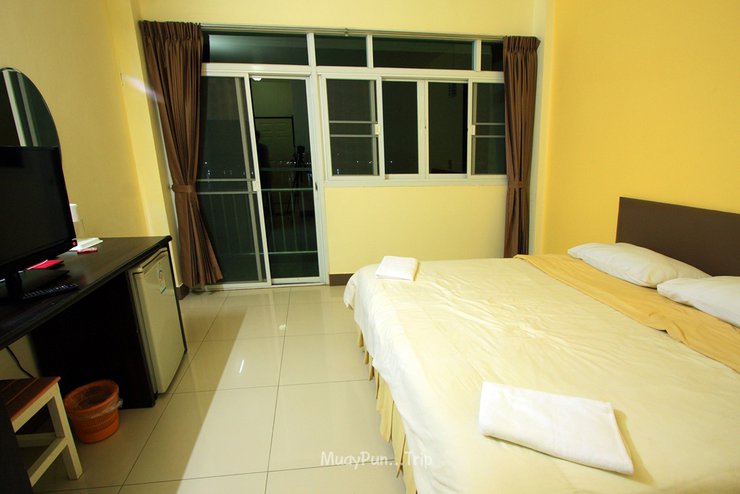Greetings! This is another rainy season trip that I would like to share with you all, exchanging travel destinations for you to read. This trip travels along the Mekong River, the Isan side of our home, to three provinces.
I departed from Don Mueang Airport around 8:00 PM and arrived at Udon Thani Airport very late at night. I hired a taxi to my accommodation for 200 baht, which was a reasonable price. Before checking in, I asked the taxi driver to stop briefly to buy some food, and he kindly obliged. He even provided me with helpful information about the area. I was fortunate to encounter such a friendly taxi driver.

The snacks on Nok Air were the usual: water and bread.

Our accommodation for tonight is at Kitlada Hotel, which is clean and looks good. The price is also affordable at 850 baht (booked through Agoda) including breakfast. The room is suitable for sleeping. In the morning, we will pick up our rental car from Hertz and travel to a destination in Udon Thani. We will then continue on to Nong Khai.

The bathroom appears clean and functional.

The atmosphere of the Kitlada Hotel is ...

After breakfast, the rental car was delivered to the hotel free of charge. I used the service of HERTZ company, purchased at the TAT event. The promotion was buy 5 days, get 1 day free. I booked a HONDA JAZZ. However, they informed me that the car had been rented out before me. Therefore, HERTZ company upgraded the car to a HONDA CVIC, which has a higher specification than the HONDA JAZZ. This was acceptable to me. (However, if you are particular about the car specifications you booked, it is recommended to confirm the car specifications again with the rental company before your trip.)

Our first stop was Phu Khon Forest Monastery, where we paid our respects to the Buddha for a safe and auspicious journey, and admired the stunning architecture.

**Phu Khon Forest Monastery is located within the Pa Na Yung National Forest Reserve.**

The expansive grounds of Wat Pa Phu Kon offer a sense of tranquility and vastness.


The temple houses the sacred relics of the Buddha enshrined in the Phra Rues Roj Sri Boorpa Buddha statue, which serves as the main presiding image in front of the Phra Pathom Chedi Maha Chedi. The temple also features the Phra Buddha Saiyasn Lokanath Sasada Mahamuni Buddha statue, a reclining Buddha statue crafted from white Carrara marble from Italy. The statue, measuring 20 meters in length, exhibits exquisite grace and was constructed during the auspicious occasion of His Majesty King Bhumibol Adulyadej's 7th cycle birthday anniversary in 2554 BE (2011 CE).



Panoramic view of Phu Khon Forest Monastery

The spacious balcony offers stunning views and a refreshing breeze, perfect for enjoying the pre-monsoon season.


Departing from Phu Khao National Park, we continued our journey towards Nong Khai Province. Before reaching our accommodation, we made a stop at Wat Pha Tak Suea.
View from the side of the road before reaching Wat Pha Tak Sue

The path leading up to Wat Pha Tak Seua is not very steep. As you drive up, you will be greeted with stunning views of the neighboring country. Wat Pha Tak Seua is located on a mountain in Sangkom District, Nong Khai Province, at an elevation of 550 meters above sea level. The temple boasts pristine natural surroundings and breathtaking views.


The Naga Staircase is a pathway leading up to the Ubosot of Wat Pha Tak Saeo, where visitors can pay respects and seek blessings from the Buddha.

Inside the church.

Exiting the church, I descended the Naga stairs and immediately headed to the viewpoint, the highlight of this location. From the viewpoint, looking to the left, one can see the Mekong River stretching out, forming a Y-shape, with a clear view of the neighboring country. (At the time of my visit, the glass bridge was not yet constructed.)
The temple houses the **Tham Din Phiang Cave**, believed to be a **serpent cave** and a **dimensional portal** connecting the human world with the underworld. Some say it was the path used by **pious Laotian monks** to cross the **Mekong River** and enter **Thailand**. At the cave entrance, there is a **shrine dedicated to "Father Pu Inthra Naga Raja - Mother Ya Ketun Naga Raja."** Unfortunately, we were unable to enter due to time constraints.




After leaving Wat Pha Tak Seua, we checked into our accommodation for the night. We opted for Dee Heng Dee Hotel, situated along the Mekong River, for a reasonable price of 550 baht (booking directly with the hotel was cheaper than Agoda). Breakfast was not included. Dee Heng Dee Hotel has two buildings: an older one and a newer one. We chose the newer building as the price was the same.

At night, I sat on the balcony and enjoyed the view of the Mekong River, the Thai-Lao Friendship Bridge, and the Lao side. The weather was cool, but not too much because it was the rainy season.

There are a couple of restaurants near the hotel. We had dinner at Ruen Rim Nam Restaurant. Next to Ruen Rim Nam is Indy Shabu Restaurant. However, I am not Korean, so I prefer to eat Thai food.

The Ruen Rim Nam Restaurant boasts a riverside location, offering stunning views of the Mekong River while you sip on refreshing drinks and relax.

For dinner, I ordered three dishes. The first was a popular Thai dish, "shrimp cakes." They were generous with the shrimp, making them a perfect accompaniment to a cold beer.

This stir-fried catfish dish falls short of expectations. The spice level and overall intensity of flavors are lacking. It needs to be significantly spicier and more robust to be considered a successful rendition of the dish. I cannot recommend it in its current state.

Another popular dish is Tom Yum Goong, a spicy soup with large prawns. The taste is strong and delicious. Overall, it was a good experience. We also enjoyed sitting by the Mekong River and feeling the breeze.

After waking up, we took a 10-minute walk to the Tha Sadet Market near our hotel.


Stroll through the souvenir shops and take photos along the way. At the edge of the Mekong River, capture the iconic photo at the "End of Thailand" sign with the naga statue.

There are displays for taking pictures.

Without hesitation, she showed off her beautiful figure.

This booth looks a bit childish.

The area around Tha Sadet Market, also known as the Indochina Market, was originally called Tha Ruea Market (meaning "boat pier market"). This name originated from the time before the construction of the Thai-Lao Friendship Bridge, when people from both sides of the Mekong River relied on boats for transportation and cross-border trade. As a result, the market became a bustling hub for trade and also served as a border checkpoint and immigration office for processing travel documents.
In 1955, a major flood occurred. King Bhumibol Adulyadej and Queen Sirikit visited the flood victims in Nong Khai Province. They disembarked from the royal barge at Tha Ruea Market. Subsequently, the market's name was changed from "Tha Ruea Market" to "Tha Sadet Market".
Tha Sadet Market is a source of products from the community of Nong Khai Province. Here, there are almost all kinds of goods, including local food, OTOP products, souvenirs, and various utensils. It depends on what the customers want to buy.
The restaurant that I would like to recommend, which I heard is delicious and is the most famous in the area, is Red Nem Nuong Restaurant. However, it's a pity that we couldn't eat there because it was closed on the day we went. T_T

It also has swiftlet houses.

After grabbing a bite to eat, we immediately set off for Bueng Kan Province. We stopped to visit and pay respects at Wat Sawang Arom, located in Pak Khat District. I believe this temple is another one that is "Useen" (meaning "sacred" or "holy"). Inside the temple, there is a chapel on top of a large rock. In the cave below, there is a reclining Buddha statue in the Parinibbana posture. Walking up to the top of the rock provides a 360-degree view of the beautiful scenery, including the Mekong River. There are also many other interesting features, such as colored sculptures, statues representing the Chinese zodiac animals, Sri Than Cave, Rishi Cave, Rishi Waterfall, Sri Than studying, Sri Than trying out a sword, the footprint of the Buddha, etc.
** Reclining Buddha in the Parinirvana Posture **


The church is built on a large rock.


Rishi Cave

Let's go upstairs to pay respects to the Buddha.



A distant view of the Mekong River.

After visiting Wat Sawang Arom, we stopped by another temple (it seems I'm becoming quite the religious person). This temple is considered a hidden gem, boasting immense charm and beauty. Wat Ahong Silawat, or Kaeng Ahong, is said to be the navel of the Mekong River.
Before entering the Wat Kao A-Hong, I took a walk along the Mekong River near the Kaeng A-Hong School. It's a beautiful spot with many islands in sight. Students were running around and playing, looking at me strangely, as if wondering who I was and what I was doing there. I smiled at the children, but they just ran away. Maybe it was because of my good looks? Haha.

The pagoda on the opposite bank belongs to Laos. I want to cross over and visit, but I'm afraid of being arrested.

See it a lot.

The view is beautiful and pleasing to the eye.



**Sign: Mekong Navel**

Legend has it that if someone drowns upstream from Ahong Rapids, their body will be found there, regardless of where they fell in. It is believed that the bodies will not flow past Ahong Rapids because they fall into a deep, swirling pool, the deepest point of the Mekong River. Additionally, Ahong Rapids is home to the world's largest freshwater fish, the Mekong giant catfish.

Departing from Kaeng A-Hong, we drove to Bueng Kan City Center, which is only a half-hour drive away. We checked in at The One Hotel, Superior Room, which we booked directly through the hotel. Fortunately, during our stay, there was a promotion, reducing the price from 1,200 THB to 790 THB.
We checked in, dropped off our luggage, and walked to the Big Lotus next to the hotel to buy some necessities and drinks (drinks are implied, hehe). After shopping, we drove out to find dinner. We took a walk along the Mekong River at Khao Mao Road. This area is bustling with people walking and looking for food. There are many restaurants and bars, making it a lively atmosphere.

This location also features a love lock bridge.

We came across Lorm Choy Grilled Fish Restaurant. My sister wanted to eat Mieng Pla, so we chose this restaurant. We ordered three dishes.
**Som Tum**, a staple dish and a personal favorite.

The stir-fried catfish dish was not delicious. It lacked the characteristic flavors of a true "pad cha" dish. The taste was not spicy enough and had a slightly fishy aftertaste.

This dish is a Nile tilapia mieng. The fish is very large and comes with a variety of side dishes. It's delicious and definitely worth trying!

In the evening, I sat and ate by the Mekong River, with Laos on the opposite bank.


The atmosphere of Khao Meao Street is considered to be the walking street of Bueng Kan.


Upon arriving at the hotel, the atmosphere surrounding The One Hotel was captivating. Regrettably, we were unable to capture the hotel room's interior for your viewing pleasure; however, you can explore it virtually on Google. We wholeheartedly affirm that The One Hotel offers exceptional value for its price. We wholeheartedly award it a perfect score of 10! .....!! Situated to the right in the image is the expansive Lotus supermarket, where you can conveniently purchase necessities and groceries with just a few steps. However, if you're feeling overheated from your excursions, we highly recommend taking a refreshing dip in the water park, which also boasts exciting amusement rides. It's important to note that we are not affiliated with The One Hotel in any marketing capacity; we simply wanted to express our genuine admiration. Haha!

The presenter in the picture has a great figure. Haha.



I can't describe it, but I can tell you that it was a lot of fun. Haha.

It was late morning when I finally left my accommodation. I drove from The One Hotel towards Chanen Waterfall, located within the Phu Wua Wildlife Sanctuary, about an hour's drive from the city center.

Reaching the waterfall was a challenging journey. The road leading to it was a rough, unpaved path through a rubber plantation. During our visit, it was the dry season, so the road was not excessively muddy, making it passable for sedans. However, during the rainy season, the waterfall has significantly less water.


There is only this much water.

During the rainy season, the cascading waterfalls of Saphan Hin create a breathtaking spectacle. The natural rock bridge, formed over time without human intervention, enhances the beauty of the waterfalls.

A villager rode a motorbike past.


During the rainy season, locals advise that this road becomes riddled with potholes, making it impassable for loaded vehicles. Four-wheel drive vehicles are recommended. However, we visited in August, during the peak rainy season, and were fortunate to experience an exceptionally dry year. As a result, the road was free of potholes and mud.

After departing from Cha Nan Waterfall, we continued driving for another half hour to Phu Tok, another USEEN that was a highlight of our trip.
The Abode of Serenity: Unveiling the Enigmatic Phutok
Nestled amidst the serene landscapes of Ban Kham Kan, Na Sa Baeng district, Bueng Kan province, lies the revered Wat Chetiya Sri Wihan, also known as Wat Phutok. Founded by the esteemed Phra Ajahn Juan Kulchettho, this sacred sanctuary translates to "the solitary mountain" in the local Isan dialect.
Phutok, a majestic natural wonder, comprises two distinct peaks: Phutok Yai (the larger peak) and Phutok Noi (the smaller peak). These peaks, further divided into seven tiers, offer a breathtaking panorama of the surrounding natural beauty.
Levels 1-2 serve as a staircase leading to Level 3, which marks the beginning of a winding bridge encircling the mountain. The environment is characterized by dense, shadowy mountain forests interspersed with rocky outcrops and open spaces. At the end of Level 3, a fork in the path emerges. The left path offers a steep shortcut directly to Level 5, traversing a narrow passage between rocks resembling a tunnel. The right path ascends to Level 4.
**Level 4** is a skywalk that winds around the mountain. Looking down, you can see rolling hills called "Dong Chompoo". To the east, it borders Phu Langka in Seka district, which is a dense forest with many streams and rivers flowing through it. It is home to a variety of wildlife, especially flocks of crows, hence the name "Phu Rangka", which eventually became "Phu Langka". On Level 4, there are accommodations for nuns. The perimeter of the level is approximately 400 meters, with rest stops at intervals.
The fifth level, or middle level, is considered the most important. It houses a large pavilion, a Buddha statue, monks' quarters, and the remains of Venerable Ajahn Juan. The area is clean and spacious, with a serene atmosphere, making it ideal for meditation and spiritual practice for pilgrims and those seeking peace. Along the walkways, there are several caves, such as the Iron Cave, the Crystal Cave, and the Hermit Cave, among others. There are places to rest along the way if you get tired. If you walk from the north, you will see a natural stone bridge leading to the Buddha Vihara, which houses the Buddha's relics. It has a unique and amazing appearance, similar to the Kyaiktiyo Pagoda in Burma. It is a rock that has separated from a larger rock but has not fallen down because it is perfectly perpendicular to the ground. Currently, there is a wooden bridge connecting the stone bridge to the Buddha Vihara. Looking out, you can clearly see the outline of the large Phu Tok mountain range. There is a spiral staircase leading to the sixth level, which is the last level of the spiral staircase around the mountain.
The 6th level offers the most breathtaking panoramic views. The trail features protruding cliffs, requiring slight detours at times. Each cliff has a unique name, such as "Pha Thep Nimit," "Pha Hua Chang," and "Pha Thep Sathit." During the winter season, a sea of mist envelops the mountain peaks, creating an ethereal atmosphere. From the 6th level, a 400-meter-long wooden bridge winds around the mountain, clinging to the edge of steep cliffs. The bridge offers thrilling and breathtaking views. The most sacred and remarkable feature of this level is the entrance to the Naga city, located behind the reclining Buddha statue. A notable feature is a white mark on the limestone, believed by locals to be a scrape caused by the belly of a Naga. A small pond with water present almost year-round can also be found here.
The seventh floor is accessible via a wooden staircase. Upon reaching the top of the stairs, there is a fork in the path leading to the rooftop. The first path is steep and requires navigating through branches and roots, making it difficult to traverse. Additionally, a sign warns of snakes, which are prevalent on this mountain peak. It is recommended to take the alternative, albeit longer, path that circles to the right. Both paths converge at the top of the seventh floor, or rooftop, which is an open forest area spanning approximately 5 rai.

Entrance to Phu Tok


Prepare to take the first step on the stairs.



The view here began to appear shortly after we started climbing.

Just as the sun was blazing, rain suddenly interrupted our walk.

Waiting for the rain to stop.

A pair of birds found shelter from the rain near us.

The rain was pouring heavily, but luckily the rock overhang provided shelter from the downpour.





Near our shelter from the rain, there was a cave opening on the cliff face above.

The cicadas emerged after the rain stopped.

The rain has stopped, leaving the atmosphere of Phu Thok shrouded in mist, offering a beautiful and refreshing view with a cool and comfortable breeze.

The view from here is absolutely stunning. It deserves a perfect score of 10 out of 10.

The entire trail is constructed of wooden planks, offering unobstructed views along the way. However, caution is advised as the wet surface can be slippery.

After walking for some time, I came across the Rishi Cave, which appeared serene and tranquil.

A large wild beehive hangs above.


The view is stunning, overlooking the Ban Na Tuen Reservoir.

This place provides accommodation for monks and those who practice precepts. If one could meditate here, one would surely attain enlightenment and see the truth clearly. And of course, ...

The thrilling path, combined with the unseen, offers a unique and exciting experience. As you walk and admire the view, you can't help but feel a thrill of excitement mixed with a touch of fear as you look down.




This statue depicts Venerable Ajahn Juan, the founder of Wat Chetiya Sri Wihan (Wat Phu Thok).

We continue walking, our destination now in sight. The air is cool and refreshing.


A panoramic view

Upon reaching the Hin Stone Bridge, the breathtaking panoramic views of both sides left me in awe.

Looking back from where we have come, the air up here is incredibly refreshing.

We have arrived at the Buddhist temple, which houses the sacred relics of the Buddha. The temple has a unique and awe-inspiring structure, resembling the Kyaiktiyo Pagoda in Myanmar. It features a large rock formation that appears to defy gravity, seemingly balanced precariously on a smaller base.

The sky after the rain is beautiful.


Entering the temple, she paid her respects and prayed. She then sat in meditation for a while, taking a break from her journey. She didn't seem tired at all and walked with ease. The Buddhist temple was peaceful, shady, and cool.

From the Buddhist temple, one can see the unique and beautiful walkways on each floor.


Opening my eyes after meditation, I saw a gecko clinging to the stone wall in front of me. Its colors were vibrant, and its body was almost as thick as my arm. It was a truly large specimen.

Mist constantly emanates from the trees.

Phu Tok is truly one of the most beautiful viewpoints in Thailand. I was very impressed and would give it a perfect score of 10 out of 10.

We'll descend from here as we won't reach the 7th floor due to the approaching dusk and potential rain. We still need to visit Bung Khong Long afterwards.


Looking back, I couldn't help but take a picture. It's beautiful no matter how you look at it.


Looking down, I felt a sudden rush of fear.




Departing from Phu Thok, we head towards Bung Khong Long, where we will spend the night.

While cycling, I saw people enjoying themselves on their bikes. It looked so relaxing, I wished I could join them.

Behold, Bung Khong Long.

Upon arriving at Kham Somboon Beach, we stopped for a relaxing dinner with a view of the Bung Khong Long Lake.

The day we went, there were no other customers. The cars parked outside belonged to the restaurant staff, not visitors. It was incredibly quiet. Only a few restaurants remained open, and I can't recall the name of the one we visited.

Our dinner tonight was herb-infused tilapia and spicy shrimp salad. The tilapia was enormous, probably over a kilo, and tasted fantastic.

Enjoying the scenic view.

During the hot season, many people come to play in the water. However, during the period we visited, the shop owner informed us that most people were busy working in the fields and did not have much time for leisure activities.


Bueng Khong Long: A Wetland of International Significance
Bueng Khong Long, located within the Bueng Khong Long Wildlife Sanctuary, is the second largest wetland in Thailand and a designated Ramsar Site of international importance (No. 1098). This vital wetland spans across two districts: Seka and Bueng Khong Long.

The atmosphere is truly wonderful.

The mountain ahead is Phu Langka.

It's getting dark, let me show you a cool picture. Hee hee.

We arrived at our accommodation late in the evening. Tonight, we are staying at Khun Napal Resort. The room is decent and affordable at 500 baht. It is the best-looking accommodation in Bung Khong Long. However, I recommend arriving before nightfall, as the road is quite dark and deserted.


The bathroom is clean and looks good.

The morning atmosphere at Khun Napal Resort


Before returning, we stopped to pay respects at another temple. We then continued our journey to "Pa Kham Chanot". When we visited, it was not as famous as it is now due to the "Nakee" soap opera. There were not many people there.

Within the sacred forest of Khao Cha-ngok

The OTOP products are mostly woven baskets, brooms, mats, etc. After taking the photos, the grandmother shouted and asked us where we were from. We answered and chatted with her while shouting (Why didn't we walk closer to the grandmother? Oh, right, haha).

**"Wang Nakin Kham Chanod" Siri Suttho Temple**, also known as **Kham Chanod Forest Temple**, is located in Ban Dung District, Udon Thani Province. It is a legendary site associated with the belief in the Naga, a mythical serpent-like creature. Locals believe that Kham Chanod Island is the dwelling place of the Naga and that it has never been flooded because the Naga protects it. However, scientific theories suggest that the island is a **floating island** due to the interconnected roots of the trees forming a solid ground. The island covers an area of approximately **20 rai (8 acres)**. It is considered a hidden gem (**Unseen**) in Thailand.
During their exploration of the area beneath Koh Samui, the Sawang Metta Rescue Foundation of Udon Thani team conducted two dives to survey the island's underwater terrain. This was an unprecedented feat, as local beliefs hold that the area surrounding the island is inhabited by crocodiles that guard the island for Chao Pu Sri Suttho (according to legend, these crocodiles are the embodiment of Chao Pu Sri Suttho's boat, which was hunted and consumed by villagers).
The second descent was to record images of Koh Samui Island. The divers descended in the same direction for 20 meters. After about 10 minutes, they received a signal to pull the rope back because they could not enter. So they pulled the signal rope to request to return to the shore.
The initial statement by the diver claimed that the bottom was a hollow space resembling a floating cave with an open path. However, the second dive revealed a dead end with long grass roots forming a solid floor, unlike the first dive, which only had sparse branches and grass roots. I attempted to clear the path, but it was impossible. When I tried to push through the grass, it felt as if someone was pulling me back, preventing me from entering. This was a very challenging exploration during the dive under Koh Kham Chano (viewer discretion advised).
The Naga Path: Gateway to the Kham Chanod Forest

The path leading into the "Pa Kham Chanod" forest has a magical aura. A particular tree species called "Chanod" grows abundantly throughout the area. As we ventured deeper, the air became refreshingly cool.



Inside the Kham Chanod Forest

The sacred well is said to be imbued with immense spiritual power, revered by the local populace. Numerous accounts exist of individuals who, upon offering their prayers at the well's edge, witnessed the fulfillment of their desires. Remarkably, those afflicted with ailments who drank from or bathed in its waters experienced miraculous recoveries, leaving them awestruck by its potency.
However, not everyone believes in the healing power of the well. Some people are skeptical and even disrespectful, using the water to wash their feet instead of seeking healing. This can lead to further suffering, as the water may not be clean and could cause infections. (Please use your own judgment when viewing this information.)




While there were a decent number of people paying respects and making offerings, the crowds were not as large as they are today, where queuing is necessary.

The large banyan tree and fig tree, in typical Thai style, are a popular spot for lottery enthusiasts. Locals have been seen sprinkling flour at the roots of the trees and rubbing it around. Some even take photos with their mobile phones to look for lucky numbers at home. It is important to note that this is purely a matter of personal belief.




Shortly after leaving "Ban Phra That Na Dun", the rain started to pour. The scenery of the rice fields in Isan was beautiful and refreshing. This trip was truly memorable, offering new experiences and a visit to an Unseen destination. Our country has many Unseen places that are just as beautiful as those abroad. Before returning the rental car and catching our flight home, we stopped for dinner at VT Naem Nua Restaurant. The food was delicious, and I highly recommend trying it. The restaurant offers a variety of dishes, including naem nua, desserts, and other snacks that are perfect for souvenirs for friends and family.
Thank you for reading our review. See you on our next trip!
Muaypun Trip
Friday, October 4, 2024 3:21 PM

